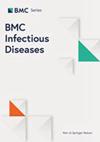摘要
背景:目前,中国大多数艾滋病病毒感染者(PLWH)对艾滋病病毒感染早期的诊断和治疗有较强的意识。新近感染的艾滋病病毒感染者的亚型特异性病毒学和免疫学特征尚未阐明:从 HIV 数据库中获取了 1508 名未经抗逆转录病毒疗法(ART)治疗的 PLWH 的 CD4 计数和病毒载量(VL)等数据,并对不同 HIV 亚型的 PLWH 进行了比较分析。利用诊断记录和 LAg-Avidity EIA 评估了中国男男性行为者队列中 402 名新确诊和抗逆转录病毒治疗(ART)失败的感染者的感染状况。根据部分 pol 基因,确定了 120 名近期感染者、68 名长期感染者和 54 名慢性感染者的 HIV 基因型。使用非参数检验比较了当地感染不同亚型 HIV 的 PLWH 的 CD4 细胞数、CD8 细胞数和 VL,以及抗逆转录病毒疗法期间 CD4 细胞数的动态变化轨迹:在 HIV 数据库中,感染 CRF01_AE 的 PLWH 的 CD4 细胞数低于感染 CRF07_BC 或 B 亚型的 PLWH。与 CRF07_BC 感染者相比,近期 CRF01_AE 感染者的 CD4 基线计数较低。在对新近感染的 PLWH 进行抗逆转录病毒疗法期间,CRF01_AE 组的 CD4 细胞数迅速增加,在抗逆转录病毒疗法后第一年年底达到高峰,而 CRF07_BC 组的 CD4 细胞数增加缓慢,在第三年年底达到平稳。B亚型组的CD4计数在ART后的头两年内显著增加并达到高峰,然后在ART后的第三年年底与CRF07_BC组的CD4计数轨迹重叠:结论:CRF01_AE能迅速降低近期感染艾滋病病毒者的CD4计数。结论:CRF01_AE 可迅速降低近期感染艾滋病病毒者的 CD4 细胞数,而 CRF01_AE 组近期感染者的 CD4 细胞数则急剧上升,并在开始接受抗逆转录病毒疗法的第一年内达到最高恢复水平。这项研究揭示了一个重要的时间点,可用于估计不同 HIV 亚型感染者 CD4 细胞数在抗逆转录病毒疗法后的恢复情况。Background: Currently, most people living with HIV (PLWH) in China have a strong awareness of diagnosis and treatment in the early stage of HIV infection. Subtype-specific virological and immunological features of recently infected PLWH have not yet been elucidated.
Methods: Data including CD4 count and viral load (VL) of 1508 anti-retroviral therapy (ART) -naïve PLWH were obtained from the HIV Database and comparatively analyzed among PLWH with different HIV subtypes. The infection status of 402 newly diagnosed and ART-naïve PLWH from a cohort of men who have sex with men (MSM) in China was evaluated using diagnosis records and LAg-Avidity EIA. Based on partial pol genes, HIV genotypes in 120 recent, 68 long-term, and 54 chronic infections were identified. The CD4 count, CD8 count, and VL, as well as trajectories of dynamic CD4 counts during ART of local PLWH with different HIV subtypes, were compared using non-parametric tests.
Results: For the HIV database, the CD4 count in PLWH with CRF01_AE was lower than that in PLWH with CRF07_BC or subtype B. For the recently infected local PLWH, CRF01_AE was the dominant HIV subtype (65.83%), followed by CRF07_BC (18.33%) and subtype B (15.83%). Recent CRF01_AE infections showed a lower baseline CD4 count than CRF07_BC infections. During ART for recently infected PLWH, the CD4 count in the CRF01_AE group rapidly increased to reach a peak at the end of the first year post-ART, while the CD4 count in the CRF07_BC group increased slowly to reach a plateau at the end of the third year. The CD4 count in the subtype B group increased significantly to reach a plateau within the first two years and then its trajectory overlapped with that of the CRF07_BC group at the end of the third year post-ART.
Conclusions: CRF01_AE rapidly reduced CD4 count during the recent HIV infection. The CD4 count of the recently infected individuals with CRF01_AE increased sharply and reached its highest level of recovery within the first year of ART initiation. This study revealed an important time point for estimating CD4 count recovery post-ART in individuals with different HIV subtypes.

 求助内容:
求助内容: 应助结果提醒方式:
应助结果提醒方式:


